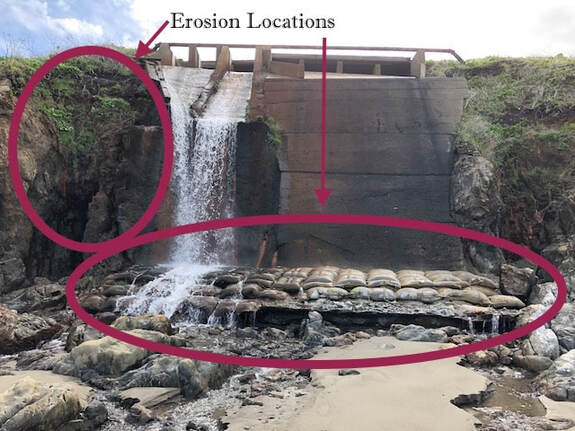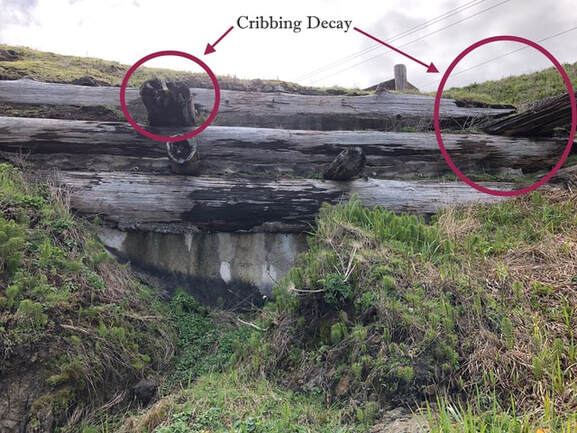"...THey are waves in an ever-changing sea that together defines the tide."
—Nina Simons, co-founder of bioneers
When the Berm Bursts
by the late William Lemos, PhD
Bill Lemos was a well respected and beloved member of the community. His contributions to coastal environmental protection community were significant. He was a member of the Consortium until his death in 2022. The last paper he wrote for FBHC is a detailed account of the likelihood of contaminants from the closed mill site entering the marine environment when the crumbling dam and berm holding back the mill ponds failed. Perched on edge of the bluff, they are vulnerable to rising sea, increasingly severe storm events, earthquake and tsunami.
Spoiler alert. This will keep you up at night.
by the late William Lemos, PhD
Bill Lemos was a well respected and beloved member of the community. His contributions to coastal environmental protection community were significant. He was a member of the Consortium until his death in 2022. The last paper he wrote for FBHC is a detailed account of the likelihood of contaminants from the closed mill site entering the marine environment when the crumbling dam and berm holding back the mill ponds failed. Perched on edge of the bluff, they are vulnerable to rising sea, increasingly severe storm events, earthquake and tsunami.
Spoiler alert. This will keep you up at night.
A no trespassing sign doesn't fulfill the promise. Nor does it protect Fort Bragg families, visitors, or ocean life. Concerns about both the dam and the berm stem from a rising sea-level and increased storm activity the coast will realistically experience in the immediate future.
The dam holding back pond 8 is constructed from redwood logs and assorted riprap--essentially flotsom and jetsom tossed over the bluff from the mill site over the years. The CA Department of Dam Safety inspected the dam in two decades ago and declared it unsafe. G-P was instructed to rebuild it with a deadline of and a daily fine for every day it remained a hazard. The dam was minimally reinforced at some point. As the oversight agency, DTSC is charged with enforcing rulings on the site. DTSC has not enforced this issue with G-P.
At one point the design of the Fort Bragg Coastal Trail had the trail veering eastward around the dam because it was thought dangerous for pedestrians. Although the Feasibility Study for remediation on OU-E is still in draft form, it appears as though the G-P's Remedial Action Plan (RAP) will include fencing off the dam, berm and beach below from hikers.
The Feasibility Study suggests that the reinforcement of the dam is adequate, as long as people are prohibited from being near the area in case of its failure. As another method to reduce future pressure on the dam, the study recommends constructing a concrete wall dividing the pond into two smaller areas. The disturbance to toxic soil during the construction of the wall is not addressed in the study. Neither are the forces caused on the western side of the dam by increased storm activity.
The berm is containing Pond 7 on the western side. Removing the berm is not recommended in the Feasibility Study because doing so would disturb toxins in that pond. Again there is no consideration given to ocean rise or storm. The ocean is within a couple of feet of the top of the berm now--with a King Tide on a calm day.
It is unknown what the damage would be to the ocean and its habitat and inhabitants if the dam or berm were to fail in a storm or earthquake event and the ponds and decades-long build-up of contaminants slide into the sea. To dismiss the concern saying that the ocean of the bluff is active and the floor is deep so the ocean could handle it--or to point smugly to the popularity of Glass Beach--is to think like humans did in the early 20th century.
The City limit ends at the western edge of the bluff. The legal boundary does not reflect the community's historic economic reliance on the ocean. It doesn't define the reason the Coastal Trail has become a major attraction. It It doesn't end it's moral responsibility to the planet.
The dam holding back pond 8 is constructed from redwood logs and assorted riprap--essentially flotsom and jetsom tossed over the bluff from the mill site over the years. The CA Department of Dam Safety inspected the dam in two decades ago and declared it unsafe. G-P was instructed to rebuild it with a deadline of and a daily fine for every day it remained a hazard. The dam was minimally reinforced at some point. As the oversight agency, DTSC is charged with enforcing rulings on the site. DTSC has not enforced this issue with G-P.
At one point the design of the Fort Bragg Coastal Trail had the trail veering eastward around the dam because it was thought dangerous for pedestrians. Although the Feasibility Study for remediation on OU-E is still in draft form, it appears as though the G-P's Remedial Action Plan (RAP) will include fencing off the dam, berm and beach below from hikers.
The Feasibility Study suggests that the reinforcement of the dam is adequate, as long as people are prohibited from being near the area in case of its failure. As another method to reduce future pressure on the dam, the study recommends constructing a concrete wall dividing the pond into two smaller areas. The disturbance to toxic soil during the construction of the wall is not addressed in the study. Neither are the forces caused on the western side of the dam by increased storm activity.
The berm is containing Pond 7 on the western side. Removing the berm is not recommended in the Feasibility Study because doing so would disturb toxins in that pond. Again there is no consideration given to ocean rise or storm. The ocean is within a couple of feet of the top of the berm now--with a King Tide on a calm day.
It is unknown what the damage would be to the ocean and its habitat and inhabitants if the dam or berm were to fail in a storm or earthquake event and the ponds and decades-long build-up of contaminants slide into the sea. To dismiss the concern saying that the ocean of the bluff is active and the floor is deep so the ocean could handle it--or to point smugly to the popularity of Glass Beach--is to think like humans did in the early 20th century.
The City limit ends at the western edge of the bluff. The legal boundary does not reflect the community's historic economic reliance on the ocean. It doesn't define the reason the Coastal Trail has become a major attraction. It It doesn't end it's moral responsibility to the planet.


